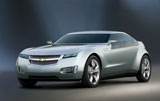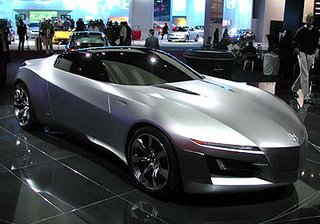For decades, auto makers have turned the creative bent of their engineers and designers loose to dream up, and then build, the most advanced concept cars imaginable. Amazingly, some of the oldest ones are some of the best, and some of the newest are some of the dullest ... it all depends on how you look at it. Here's just a few ...
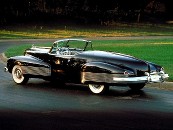 Let's start with the first one. The 1938 Buick Y Car, designed by the infamous Harley Earl who went on the design other historic GM car models. Wondering what to call the concept car, in the midst of some experimental vehicles (as they were called at the time), General Motors wanted it to be named something different. "Y" was (alphabetically anyway) after "X", so the Y Car is what it became. Hidden headlights, and a convertible top that recessed under a metal cover when the top was down, were two features that went on to be built decades later in cars of the late Twentieth and early Twenty-first Centuries. Harley Earl was so enthralled with the car (even though the GM engineers went on to even better designs in subsequent years) that he continued to drive the Y Car around Detroit streets for years. Eventually it ended up in a warehouse where it was ignored for decades before being restored to its former glory.
Let's start with the first one. The 1938 Buick Y Car, designed by the infamous Harley Earl who went on the design other historic GM car models. Wondering what to call the concept car, in the midst of some experimental vehicles (as they were called at the time), General Motors wanted it to be named something different. "Y" was (alphabetically anyway) after "X", so the Y Car is what it became. Hidden headlights, and a convertible top that recessed under a metal cover when the top was down, were two features that went on to be built decades later in cars of the late Twentieth and early Twenty-first Centuries. Harley Earl was so enthralled with the car (even though the GM engineers went on to even better designs in subsequent years) that he continued to drive the Y Car around Detroit streets for years. Eventually it ended up in a warehouse where it was ignored for decades before being restored to its former glory.

Another 1939 concept car, the Aston Martin Atom body included aluminum panels that gave it a look of silver. The prototype spent time in French design museums before returning to England in 1985, decades later. It then took ten years to restore the Atom to the condition seen here.
In some ways the 1948 Gatso Roadster looked similar to the Aston Martin Atom built before the war, but was powered by a V-8 engine and a 6 speed gearbox. The odd third headlight in the center above the grill, the car eventually was built on a Ford chassis. At one point the model was called the Gatford, until Ford balked because in France it sold vehicles under the Matford name so the company changed the name to Gatso. Still, the look was unique.
Aston Martin Atom built before the war, but was powered by a V-8 engine and a 6 speed gearbox. The odd third headlight in the center above the grill, the car eventually was built on a Ford chassis. At one point the model was called the Gatford, until Ford balked because in France it sold vehicles under the Matford name so the company changed the name to Gatso. Still, the look was unique.
Harley Earl's designer team gave Harley another concept car that he loved so much that he drove it around Detroit for years, much like he did the 1938 Buick Y. This one was the 1951 Buick LeSabre, modeled after the jet fighter plane and equipped with a gas and alcohol fuel system. Wilder yet, the convertible car was equpped with a rain sensor device that would raise the top if it started raining and the owner was away from the car. There was nothing else like it and Harley liked it that way. From time to time the car has reappeared at special auto shows and displays. A remarkable car.
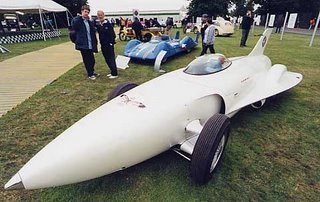
And then there was the first Firebird, the 1954 Firebird I. It didn't even look like a car. More like a jet with wheels. It even had a canopy and wings! You have to figure that some GM design engineer took a ride in a jet and came back, downed a bottle of whiskey, and designed the car totally drunk! Not to be outdone, though, the advertising department then put together a great looking brochure too.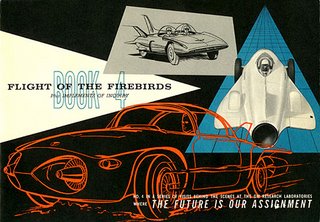
It was followed in the late 50's by the Firebird II and the Firebird III.
The first Firebird debuted at the 1953 Autorama show, and the II and III models followed in subsequent shows. Millions of people saw the designs and styling cues made their way into the late 50's and early 60's GM street cars. The Firebird's story, including details on its turbine engines, can be found here.
The 1941 Chrysler Thunderbolt was intended to be an aluminum sportscar with a fully retractable hardtop that an electric motor retracted into the trunk when you pushed the "down" dashboard button. Unusual features included power windows and concealed headlamps (remember this was 1941). The Thunderbolt is believed to be the first concept car ever displayed to the public at large and six of them were actually built. Amazingly, they were all sold in 1941 and all six of them still survive. Subsequent concept cars usually lasted a year or so and were destroyed as a matter of routine.
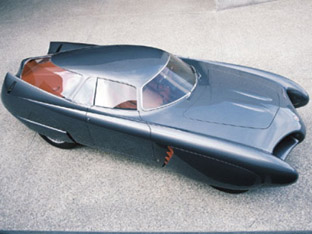
The 1953 Alfa Bat 3 actually started out a year or so before when Italian designers started to work on what would end up as 3 vehicles that were actually built. The rear tapering design looked like its namesake. The 90 horsepower engine and five speed transmission could shoot the light bodied car up to 125 mph in short order and the front end design actually reduced airflow problems at high speed, just as it was designed to do.
No, it's not a Corvette. In 1955 Harley Earl's team did it again.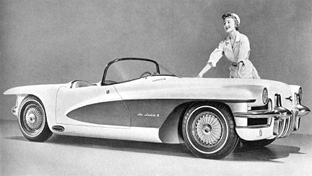
This time introducing a remarkable design for the time which was met with public ridicule, as just too "Buck Rogers." The Cadillac La Salle II was a four door hardtop sedan. Two hardtops and one convertible were built for the GM Motorama tour. Its unibody construction forecast a construction style that would not be mainstream for years to come. The "open" rear wheel design, however, was a flash in the pan. The two hardtops were destroyed but the convertible was found in a junkyard in the 1990s and restored.
You just never know what you might find in that back lot. Hundreds of prototype and concept cars have literally disappeared over the years, most thought to have been scrapped.
For a list of the prototype, concept and show cars that have appeared at auto shows over the years, click here. The history of concept cars shows the remarkable designs that the best engineers and designers have dreamed up over the years. Most concept cars never get beyond the drawing board. Some get to the clay stage. A few actually get built and appear at auto shows. Still, many of their novel "bells and whistles" end up on the cars you and I buy every year.
For more concept cars, like the Mercedes Bionic, click here.
 Let's start with the first one. The 1938 Buick Y Car, designed by the infamous Harley Earl who went on the design other historic GM car models. Wondering what to call the concept car, in the midst of some experimental vehicles (as they were called at the time), General Motors wanted it to be named something different. "Y" was (alphabetically anyway) after "X", so the Y Car is what it became. Hidden headlights, and a convertible top that recessed under a metal cover when the top was down, were two features that went on to be built decades later in cars of the late Twentieth and early Twenty-first Centuries. Harley Earl was so enthralled with the car (even though the GM engineers went on to even better designs in subsequent years) that he continued to drive the Y Car around Detroit streets for years. Eventually it ended up in a warehouse where it was ignored for decades before being restored to its former glory.
Let's start with the first one. The 1938 Buick Y Car, designed by the infamous Harley Earl who went on the design other historic GM car models. Wondering what to call the concept car, in the midst of some experimental vehicles (as they were called at the time), General Motors wanted it to be named something different. "Y" was (alphabetically anyway) after "X", so the Y Car is what it became. Hidden headlights, and a convertible top that recessed under a metal cover when the top was down, were two features that went on to be built decades later in cars of the late Twentieth and early Twenty-first Centuries. Harley Earl was so enthralled with the car (even though the GM engineers went on to even better designs in subsequent years) that he continued to drive the Y Car around Detroit streets for years. Eventually it ended up in a warehouse where it was ignored for decades before being restored to its former glory.
Another 1939 concept car, the Aston Martin Atom body included aluminum panels that gave it a look of silver. The prototype spent time in French design museums before returning to England in 1985, decades later. It then took ten years to restore the Atom to the condition seen here.
In some ways the 1948 Gatso Roadster looked similar to the
 Aston Martin Atom built before the war, but was powered by a V-8 engine and a 6 speed gearbox. The odd third headlight in the center above the grill, the car eventually was built on a Ford chassis. At one point the model was called the Gatford, until Ford balked because in France it sold vehicles under the Matford name so the company changed the name to Gatso. Still, the look was unique.
Aston Martin Atom built before the war, but was powered by a V-8 engine and a 6 speed gearbox. The odd third headlight in the center above the grill, the car eventually was built on a Ford chassis. At one point the model was called the Gatford, until Ford balked because in France it sold vehicles under the Matford name so the company changed the name to Gatso. Still, the look was unique.
Harley Earl's designer team gave Harley another concept car that he loved so much that he drove it around Detroit for years, much like he did the 1938 Buick Y. This one was the 1951 Buick LeSabre, modeled after the jet fighter plane and equipped with a gas and alcohol fuel system. Wilder yet, the convertible car was equpped with a rain sensor device that would raise the top if it started raining and the owner was away from the car. There was nothing else like it and Harley liked it that way. From time to time the car has reappeared at special auto shows and displays. A remarkable car.

And then there was the first Firebird, the 1954 Firebird I. It didn't even look like a car. More like a jet with wheels. It even had a canopy and wings! You have to figure that some GM design engineer took a ride in a jet and came back, downed a bottle of whiskey, and designed the car totally drunk! Not to be outdone, though, the advertising department then put together a great looking brochure too.

It was followed in the late 50's by the Firebird II and the Firebird III.
The first Firebird debuted at the 1953 Autorama show, and the II and III models followed in subsequent shows. Millions of people saw the designs and styling cues made their way into the late 50's and early 60's GM street cars. The Firebird's story, including details on its turbine engines, can be found here.

The 1941 Chrysler Thunderbolt was intended to be an aluminum sportscar with a fully retractable hardtop that an electric motor retracted into the trunk when you pushed the "down" dashboard button. Unusual features included power windows and concealed headlamps (remember this was 1941). The Thunderbolt is believed to be the first concept car ever displayed to the public at large and six of them were actually built. Amazingly, they were all sold in 1941 and all six of them still survive. Subsequent concept cars usually lasted a year or so and were destroyed as a matter of routine.

The 1953 Alfa Bat 3 actually started out a year or so before when Italian designers started to work on what would end up as 3 vehicles that were actually built. The rear tapering design looked like its namesake. The 90 horsepower engine and five speed transmission could shoot the light bodied car up to 125 mph in short order and the front end design actually reduced airflow problems at high speed, just as it was designed to do.
No, it's not a Corvette. In 1955 Harley Earl's team did it again.

This time introducing a remarkable design for the time which was met with public ridicule, as just too "Buck Rogers." The Cadillac La Salle II was a four door hardtop sedan. Two hardtops and one convertible were built for the GM Motorama tour. Its unibody construction forecast a construction style that would not be mainstream for years to come. The "open" rear wheel design, however, was a flash in the pan. The two hardtops were destroyed but the convertible was found in a junkyard in the 1990s and restored.
You just never know what you might find in that back lot. Hundreds of prototype and concept cars have literally disappeared over the years, most thought to have been scrapped.
For a list of the prototype, concept and show cars that have appeared at auto shows over the years, click here. The history of concept cars shows the remarkable designs that the best engineers and designers have dreamed up over the years. Most concept cars never get beyond the drawing board. Some get to the clay stage. A few actually get built and appear at auto shows. Still, many of their novel "bells and whistles" end up on the cars you and I buy every year.
For more concept cars, like the Mercedes Bionic, click here.

